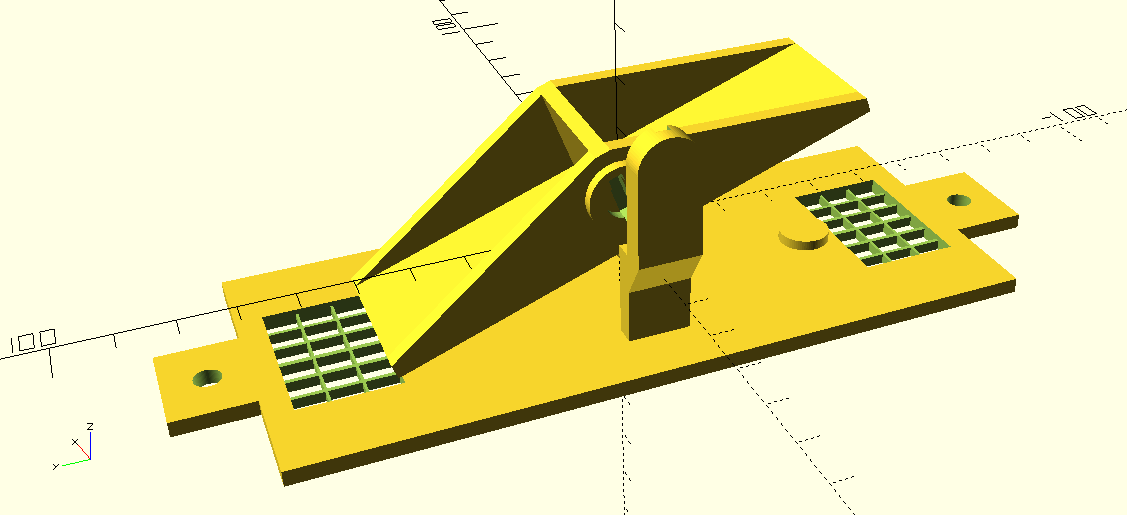Tipping bucket rain gauge
-
So I am working on my own version of a tipping bucket rain gauge. I know there is the one from BulldogLowell, so why am I doing it this way? Because I have a 3D printer and some design knowledge, and really, just because I can. So here is what I have so far. Basically, the bucket mechanism with the bottom plate which I designed in OpenSCAD.
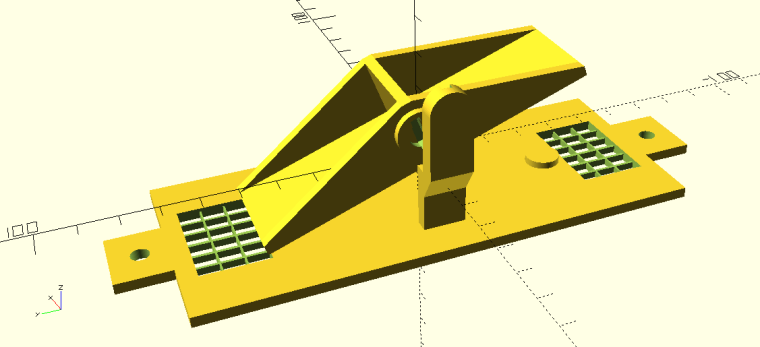
I have not designed the funnel cover yet because I have some questions if anyone knows the answers. I did try to google this, but wasn't finding exactly what I was looking for.My main question is, does the funnel have to be a certain size? Obviously, the larger the funnel, the more water that is going to get captured, so I would assume that there is some kind of spec or formula for that. I checked the bucket mechanism and each side holds about 9.75 ml of water. What other information do I need to know?
-
So I am working on my own version of a tipping bucket rain gauge. I know there is the one from BulldogLowell, so why am I doing it this way? Because I have a 3D printer and some design knowledge, and really, just because I can. So here is what I have so far. Basically, the bucket mechanism with the bottom plate which I designed in OpenSCAD.

I have not designed the funnel cover yet because I have some questions if anyone knows the answers. I did try to google this, but wasn't finding exactly what I was looking for.My main question is, does the funnel have to be a certain size? Obviously, the larger the funnel, the more water that is going to get captured, so I would assume that there is some kind of spec or formula for that. I checked the bucket mechanism and each side holds about 9.75 ml of water. What other information do I need to know?
the most important thin is really the diameter of the bucket. There are standards for that (8in in the US).
Once you know how many tips per millimeter of rain you are good. you need to test it to calibrate it. The energy in the falling droplets and surface tension affect the volume of the water per tip. I sprayed rain-x on the inner cone of the funnel so that all the droplets dribble down. you can lose some to evaporation if you have a very light rain and the weather is hot.
Put a calibration method into your program, and you will be fine.
can't wait to see your final design!
-
the most important thin is really the diameter of the bucket. There are standards for that (8in in the US).
Once you know how many tips per millimeter of rain you are good. you need to test it to calibrate it. The energy in the falling droplets and surface tension affect the volume of the water per tip. I sprayed rain-x on the inner cone of the funnel so that all the droplets dribble down. you can lose some to evaporation if you have a very light rain and the weather is hot.
Put a calibration method into your program, and you will be fine.
can't wait to see your final design!
@BulldogLowell Do you know where I can find information on that standard? This is the style I was looking to make:
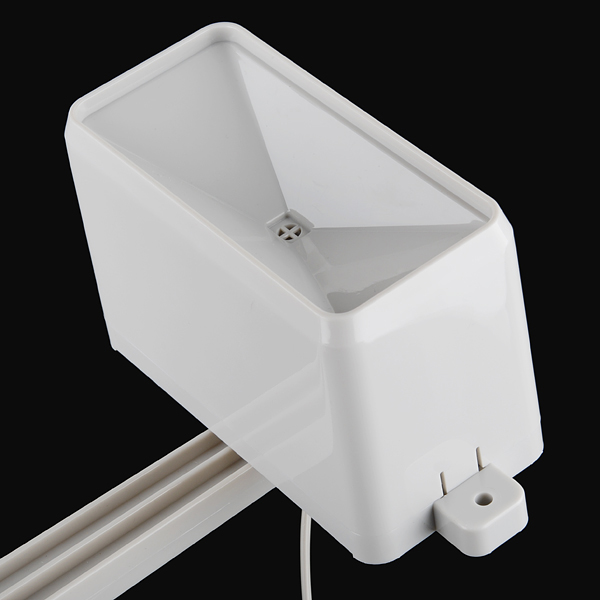
So, if you are saying that the standard in the US is 8 inches for a round bucket style gauge, I would assume then that if I created a rectangular bucket style, the funnel opening should be roughly 50.27 square inches which is the area of an 8 inch circle.Finding out the amount of water per tip is easy. I can watch it for a while with the faucet trickling on it and see how full one bucket normally is when it tips. I can then fill one of the buckets to that level and measure it's capacity. But, you say "Once you know how many tips per millimeter of rain you are good", which by the way would be inches in the US. Over what area is that determined? 1mm of water in the bottom of a 5 liter bucket is significantly more that 1mm of water in the bottom of a soda can.
I will certainly put a calibration method in, I just need to know how to figure out what that is.
-
You should have some kind of adjustment-pins underneath the buckets sides
some links that I used when I calibrated my Rain gauge
http://www.instructables.com/id/Arduino-Rain-Gauge-Calibration/
if you use ellipse funnel
http://www.csgnetwork.com/areaellipse.html -
You should have some kind of adjustment-pins underneath the buckets sides
some links that I used when I calibrated my Rain gauge
http://www.instructables.com/id/Arduino-Rain-Gauge-Calibration/
if you use ellipse funnel
http://www.csgnetwork.com/areaellipse.html -
@BulldogLowell Do you know where I can find information on that standard? This is the style I was looking to make:

So, if you are saying that the standard in the US is 8 inches for a round bucket style gauge, I would assume then that if I created a rectangular bucket style, the funnel opening should be roughly 50.27 square inches which is the area of an 8 inch circle.Finding out the amount of water per tip is easy. I can watch it for a while with the faucet trickling on it and see how full one bucket normally is when it tips. I can then fill one of the buckets to that level and measure it's capacity. But, you say "Once you know how many tips per millimeter of rain you are good", which by the way would be inches in the US. Over what area is that determined? 1mm of water in the bottom of a 5 liter bucket is significantly more that 1mm of water in the bottom of a soda can.
I will certainly put a calibration method in, I just need to know how to figure out what that is.
@dbemowsk said in Tipping bucket rain gauge:
@BulldogLowell Do you know where I can find information on that standard?
I tried using google...
the style you bought is OK (I built one like that) but two observations:
- The projected area is small - sample size is not that great and won't be as accurate, if that is any concern to you. It may not even measure in some cases.
- the cup itself is very shallow, and rain will easily splatter out of the device and not get measured. That would also affect its accuracy.
-
@dbemowsk said in Tipping bucket rain gauge:
@BulldogLowell Do you know where I can find information on that standard?
I tried using google...
the style you bought is OK (I built one like that) but two observations:
- The projected area is small - sample size is not that great and won't be as accurate, if that is any concern to you. It may not even measure in some cases.
- the cup itself is very shallow, and rain will easily splatter out of the device and not get measured. That would also affect its accuracy.
@BulldogLowell I didn't buy that style, I was just using that as an example when I started my design. I am in the process of designing my own in OpenSCAD. I can modify the design to my liking. When you mentioned that an 8 inch cup opening is the US standard, I figured that would be a good place to start. You also mentioned about the cup in the above picture being shallow. I can easily make it with a higher wall to the cup to prevent splashing. I am going to work more on the design tonight and will post more pics as I get further along in the design.
-
@dbemowsk said in Tipping bucket rain gauge:
@BulldogLowell Do you know where I can find information on that standard?
I tried using google...
the style you bought is OK (I built one like that) but two observations:
- The projected area is small - sample size is not that great and won't be as accurate, if that is any concern to you. It may not even measure in some cases.
- the cup itself is very shallow, and rain will easily splatter out of the device and not get measured. That would also affect its accuracy.
@BulldogLowell Just out of curiosity, I was looking at your design and the one you made is only ~130mm in diameter. Why not 8in ( 203.2mm )?
-
@BulldogLowell Just out of curiosity, I was looking at your design and the one you made is only ~130mm in diameter. Why not 8in ( 203.2mm )?
I made that as a project for a maker-faire. As I recall, I was benchmarking Netatmo.
My personal rain gauge is the typical 8 inch. I'm in a very tropical environment with lots of rain, so I went with an 8in as to not overflow. Plus, I put some sharp pins to keep the birds out!
-
I made that as a project for a maker-faire. As I recall, I was benchmarking Netatmo.
My personal rain gauge is the typical 8 inch. I'm in a very tropical environment with lots of rain, so I went with an 8in as to not overflow. Plus, I put some sharp pins to keep the birds out!
@BulldogLowell I have seen some designs where people make a spiked lip for that reason.
-
Well here are some updates to my design. I am looking for feedback to see what people think and if I should change things at all.
So here are some pics of my proposed funnel/cover design:
This is the top view of my cup design. The inside diameter of the cup is 203.2mm (8 inches). The inner lip above the actual funnel is around 20mm.
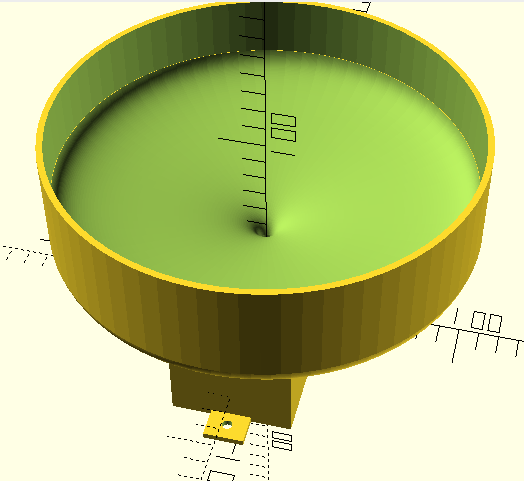
This is 2 side views showing the transition of the cup to the base.
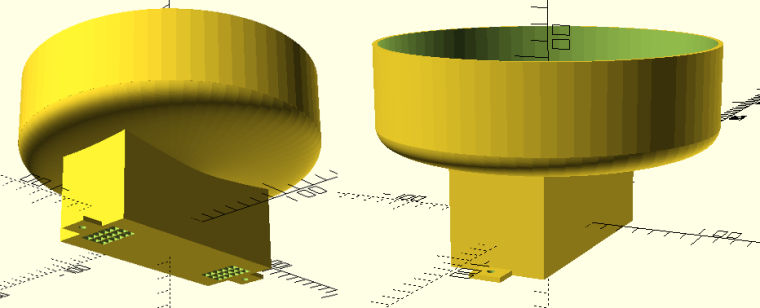
This next two images show the inside of the gauge with the buckets sitting level to show the funnel opening and the distance to the buckets which is 5mm. The funnel opening I have at 6mm. This should ensure that the funnel dumps directly into the buckets with minimal splash. I am wondering though if I should make the funnel opening larger. Is there a standard for this like there is for the cup size, or doesn't it matter?

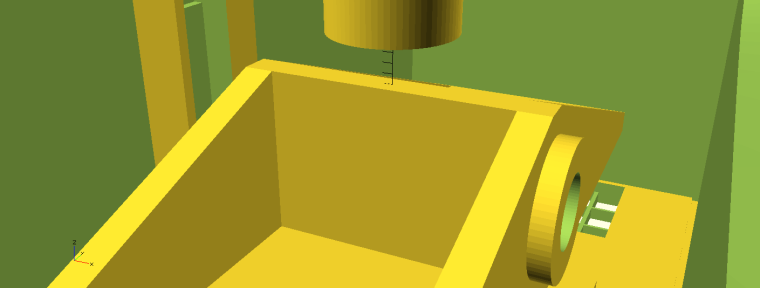
This is the magnetic reed switch that I plan to use which was a lid closed sensor that I pulled out of an old laptop. I have a small 4.2mm round neodymium magnet that I plan to mount on the side of the cup.

Here you can see the slot in the upright that will hold the reed switch. The wire will come out the side of the pillar through the hole in the top. At the bottom is the screw hole for securing it with a 2mm x 5mm screw. I have also added 2 adjustment screw holes for the buckets which I didn't have in my original base design.
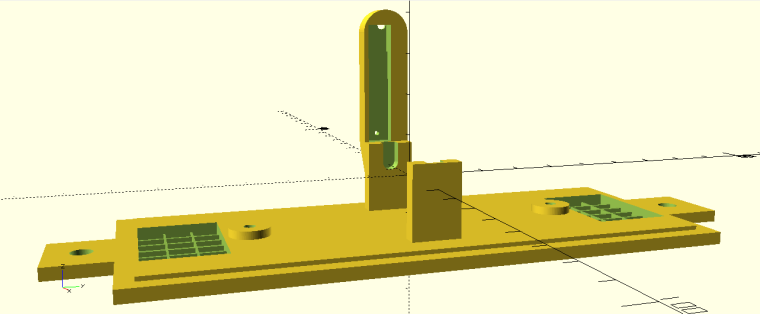
Here is a view with the tipping buckets in place.

I do not plan on housing the electronics in this unit. My big picture plan is that this will be a part of a full weather station in which I will probably build an enclosure just for the electronics that most of the sensors will get wired to.
As I mentioned. I am looking for thoughts from others. I welcome any and all feedback on the design. Once the whole thing is done, I will be posting it on thingiverse for all to have access to.
Thanks for being a great support forum.
-
I made that as a project for a maker-faire. As I recall, I was benchmarking Netatmo.
My personal rain gauge is the typical 8 inch. I'm in a very tropical environment with lots of rain, so I went with an 8in as to not overflow. Plus, I put some sharp pins to keep the birds out!
@BulldogLowell When I started doing this I just basically copied your .stl file (Bucket.stl) from your project that is posted in the build section of the site. I just converted it to OpenSCAD and the only real change I made was that on yours, you have holes that a rod goes through for it to pivot on. Mine has 2 pegs on the side that allow it to sit in 2 slots for pivoting. Here is a pic of your .stl file:

Here is a pic of mine, and the question I have is, what are the circular things that you have on the side of the buckets? Are they there for a purpose, and if so, what is it? I only included them in mine because you had them in your design.
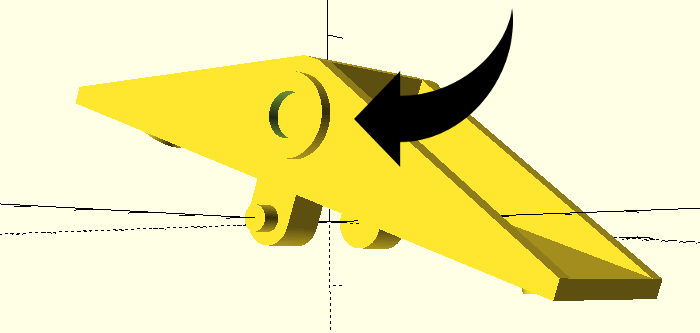
-
sorry for the late response!!!
those rings is where I glued my magnet!
-
sorry for the late response!!!
those rings is where I glued my magnet!
@BulldogLowell I thought that's what it was for, but wasn't sure. Any advice on the upper funnel/cover?
-
@BulldogLowell I thought that's what it was for, but wasn't sure. Any advice on the upper funnel/cover?
I like it a lot. I'm guessing that the depth is about 2in on the sides, which I'm sure that will be OK to avoid splashing out.
If you live near trees, you may want to think about how to keep leaves out . A screen or pointy things will also keep out any animals!
your printer must be plenty big to get that 8in diameter funnel... nice!
-
I like it a lot. I'm guessing that the depth is about 2in on the sides, which I'm sure that will be OK to avoid splashing out.
If you live near trees, you may want to think about how to keep leaves out . A screen or pointy things will also keep out any animals!
your printer must be plenty big to get that 8in diameter funnel... nice!
@BulldogLowell My plan is to mount it on the edge of my garage roof far away from my trees. I have seen designs with spikes for keeping birds off. I think I will work those into the model before printing.
My hot bed is 220 x 220mm which is 8.6" square. It should just fit if it is centered correctly.

